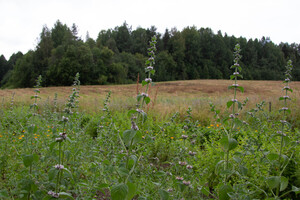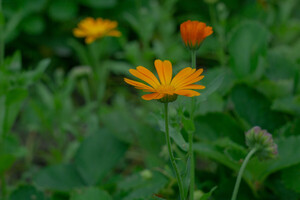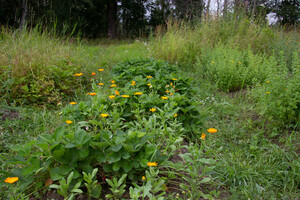The pharmaceutical industry widely uses such medicinal and essential-oil crops as marigold, mint, lemon balm, thyme, rhodiola and others. In Russia, they are mainly grown in the Altai and Stavropol regions, in the Crimea and some farms in the Central Black Earth region of the country. Scientists argue that Karelia could also become a supplier of medicinal plants. Moreover, in the edaphic and climatic conditions of the north, crops accumulate essential oils with properties beneficial to humans more actively than in the south. To ensure successful cultivation of these species it is necessary to search for economically advantageous techniques. This task was undertaken by scientists at the Karelian Research Center RAS within a project funded by Russian Science Foundation grant #23-26-10057.
Researchers compared the efficiency of outdoor cultivation in two seeding methods: monoculture vs. intercropping. Intercropping implies growing two (binary) or more crops together in the same field. The intercropping technique is more effective in promoting the yield and the stress tolerance of plants. Combined crops are less suppressed by weeds and are more tolerant of unfavorable conditions.
— If the plant species for intercropping are well selected for matching biological and economic traits, their joint cultivation facilitates a fuller utilization of light, moisture, nutrients and other environmental conditions. The plants use soil fertility to the fullest, as the root systems of different plants develop in different soil horizons and the above-ground biomass takes up solar energy in different layers. Properly arranged crops can increase soil fertility and the productivity of the agrocoenoses, — explained Maria Yurkevich, author of the study, Head of the Plant Biotechnology Laboratory, Department for Multidisciplinary Research KarRC RAS.
It is known however that intercropped plants can suppress each other while competing for environmental resources, so their combinations are to be selected properly.
The scientists tested how such medicinal crops as peppermint, lemon balm, garden strawberry, and pot marigold would grow and develop outdoors in the North. Dill was selected as the supplementary crop. The studied plant species belong to different families and genera, have different biological properties and differ in chemical composition. Experiments are conducted at KarRC RAS Agrobiological Station, where a collection of medicinal plants made up of 27 species of seven pharmacological groups has been established.
The first results of the study have already been published in the international journal Web of Conferences. It was found that when combined in binary crops with lemon balm, mint and strawberry, marigold inhibits their growth and development. At the same time, binary crops with dill produce higher yields of mint and lemon balm.
Intercropping significantly reduces the rate of transpiration, i.e. water evaporation by plants. Photosynthesis rate depends largely on the plants' species-specific characteristics. Thus, strawberry in binary crops has higher photosynthetic activity, while mint and lemon balm, on the contrary, had higher photosynthesis rates in mono-species cultivation.
— Also, we studied the response of marigold to fertilization. When young, this species does not need much fertilization, but it will be required during blossom. Marigold is highly responsive to liming, which multiplies the yield, — remarked Maria Yurkevich.
Also within this RSF project, an academic article was published on perennial Allium species and their potential as valuable medicinal resources. Alliums feature high nutritional value and a significant content of vitamin C, they are rich in vitamins, trace elements and amino acids, and are a valuable source of selenium, copper, zinc, manganese and iron.
This field season, a new experiment with garden strawberries has been launched at the KarRC RAS Agrobiological Station. Scientists will assess how different doses of fertilizers influence the growth and development of the plant.
News

July 31, 2024
Scientists seeking to augment medicinal plant yield in the North
Medicinal plants can be grown in Karelia as raw materials for the pharmaceutical industry. This is what scientists at the Karelian Research Center RAS strongly believe. Researchers implement experiments to find out how different agricultural practices can influence crop yields and production profitability. In particular, they assessed how plants develop in the north when growing separately or together with other crops. For example, calendula inhibits the growth of lemon balm and mint, while dill, on the contrary, augments their yields.
Medicinal plants can be grown in Karelia as raw materials for the pharmaceutical industry. This is what scientists at the Karelian Research Center RAS strongly believe. Researchers implement experiments to find out how different agricultural practices can influence crop yields and production profitability. In particular, they assessed how plants develop in the north when growing separately or together with other crops. For example, calendula inhibits the growth of lemon balm and mint, while dill, on the contrary, augments their yields.
See also:
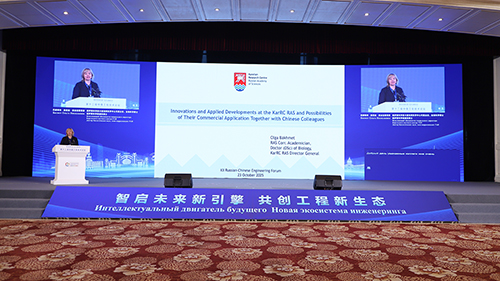
October 27, 2025
KarRC RAS Director General Olga Bakhmet presented practical developments by Karelian scientists at the 12th China-Russia Engineering and Technology Forum
KarRC RAS Director General Olga Bakhmet delivered a plenary talk at the 12th China-Russia Engineering and Technology Forum in the Chinese Harbin. The CEO presented our scientists’ developments in biotechnology, aquaculture, remote sensing, greenhouse gas monitoring, geology, and other fields, as well as announced the international environmental conference on the BRICS regional-level cooperation to take place in Petrozavodsk next year.
KarRC RAS Director General Olga Bakhmet delivered a plenary talk at the 12th China-Russia Engineering and Technology Forum in the Chinese Harbin. The CEO presented our scientists’ developments in biotechnology, aquaculture, remote sensing, greenhouse gas monitoring, geology, and other fields, as well as announced the international environmental conference on the BRICS regional-level cooperation to take place in Petrozavodsk next year.
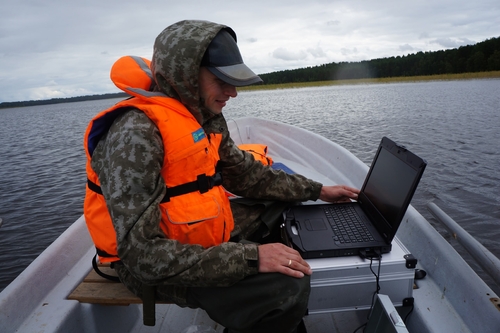
October 26, 2025
Scientists of KarRC RAS tested a new underwater acoustic system in freshwater bodies
A new underwater acoustic system was tested out in the field by specialists of the Laboratory of Fish and Aquatic Invertebrates Ecology, Institute of Biology KarRC RAS, during an expedition to Lake Syamozero in the summer 2025. The device was used to estimate the fish stocks, to determine the fish species composition, and to map the lake’s depths.
A new underwater acoustic system was tested out in the field by specialists of the Laboratory of Fish and Aquatic Invertebrates Ecology, Institute of Biology KarRC RAS, during an expedition to Lake Syamozero in the summer 2025. The device was used to estimate the fish stocks, to determine the fish species composition, and to map the lake’s depths.




